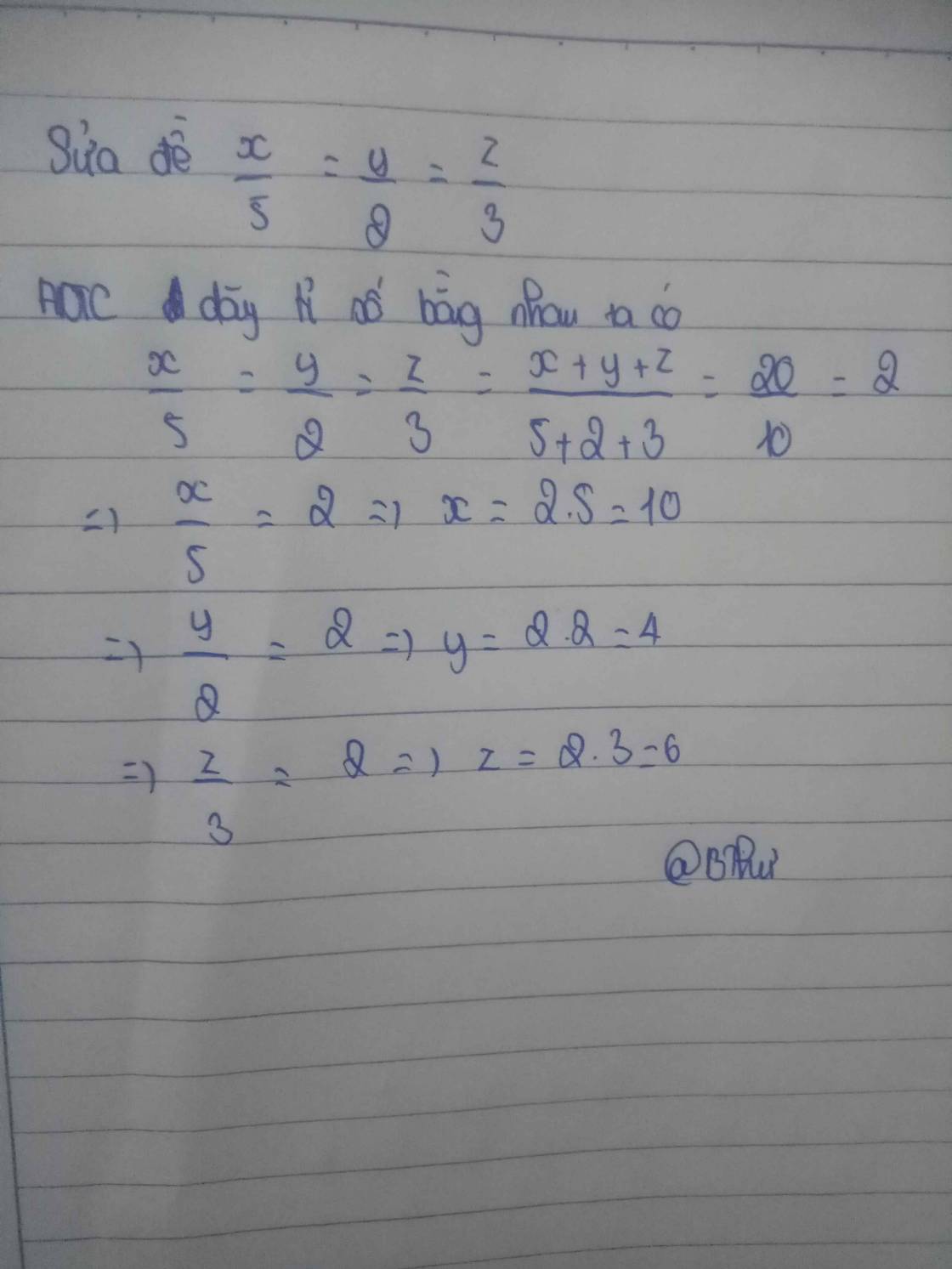
Hãy nhập câu hỏi của bạn vào đây, nếu là tài khoản VIP, bạn sẽ được ưu tiên trả lời.


\(\dfrac{x}{5}=\dfrac{y}{2}=\dfrac{z}{3}\) đề ntn phải ko ạ
mà x+y+z=20
áp dụng DTSBN ta có
\(\dfrac{x}{5}=\dfrac{y}{2}=\dfrac{z}{3}=\dfrac{x+y+z}{5+2+3}=\dfrac{20}{10}=2\\ =>x=2\cdot5=10\\ y=2\cdot2=4\\ z=2\cdot3=6\)

/x+5/+/x-1/=12:/y+5/+3
suy ra x+5+x-1=12:/y+5/+3 hoặc x+5+x-1=12:-<y+5>+3

Ta có
(x+8)/10+(x+7)/11+(x+6)/12=(x+5)/13+(x+4)/14-1
<=>(x+8)/10+1+(x+7)/11+1+(x+6)/12+1=(x+5)/13+1+(x+4)/14-1+2( giải thích là cộng mỗi vế với 3)
<=>(x+18)/10+(x+18)/11+(x+18)/12=(x+18)/13+(x+18)/14
<=>(x+18)/10+(x+18)/11+(x+18)/12-(x+18)/13-(x+18)/14=0
<=>(x+18)(1/10+1/11+1/12-1/13-1/14)=0
Hai số nhân lại bằng không khi và chỉ khi một trong hai số bằng không hoặc cả hai số bằng không mà
1/10+1/11+1/12-1/13-1/14 khác không
<=>x+18=0
<=>x=-18
Nhớ k mik nhé

=> (\(^{4^4}\) -\(^x\) ).5=3.(\(^x\) -12)
=>(256-x).5=3.(x-12)
=> 1280-5x=3x-36
=> 1280 +36= 3x+5x
=> 1316= 8x
=> x= 1316:8
=> x =164,5

a: \(\Leftrightarrow\dfrac{1}{x+2}-\dfrac{1}{x+5}+\dfrac{1}{x+5}-\dfrac{1}{x+10}+\dfrac{1}{x+10}-\dfrac{1}{x+17}=\dfrac{x}{\left(x+2\right)\left(x+17\right)}\)
=>\(\dfrac{x+17-x-2}{\left(x+2\right)\left(x+17\right)}=\dfrac{x}{\left(x+2\right)\left(x+17\right)}\)
=>x=15
b: \(\Leftrightarrow-\dfrac{1}{x-1}+\dfrac{1}{x-3}-\dfrac{1}{x-3}+\dfrac{1}{x-8}-\dfrac{1}{x-8}+\dfrac{1}{x-20}-\dfrac{1}{x-20}=\dfrac{-3}{4}\)
=>1/x-1=3/4
=>x-1=4/3
=>x=7/3

Đặt \(\left|x-12\right|=t\ge0\Rightarrow\left(\left|x-12\right|\right)^2=\left(x-12\right)^2=t^2\) thay vào đẳng thức ta được :
\(2014t+t^2=2013t\)\(\Leftrightarrow t^2+2014t-2013t=0\Leftrightarrow t^2+t=0\)
\(\Leftrightarrow t\left(t+1\right)=0\Rightarrow\orbr{\begin{cases}t=0\\t=-1\left(l\right)\end{cases}}\)
\(\Rightarrow\left|x-12\right|=0\Rightarrow x=12\)
Vậy \(x=12\)

\(\frac{11}{12}-\left(\frac{2}{5}+x\right)=\frac{2}{3}.\left(6x+1\right)\)
\(\Rightarrow\frac{11}{12}-\frac{2}{5}-x=\frac{2}{3}.6x+\frac{2}{3}\)
\(\Rightarrow\frac{55-24}{60}-x=4x+\frac{2}{3}\)
\(\Rightarrow\frac{31}{60}-x=4x+\frac{2}{3}\)
\(\Rightarrow\frac{31}{60}-\frac{2}{3}=4x+x=5x\)
\(\Rightarrow5x=-\frac{11}{60}\)
\(\Rightarrow x=\frac{-11}{300}\)

P(x) = x2 - 2x + 7x3 - 12
Q (x) = x3 - 2x2 + 5 - 5
=> P(x) = 7x3 + x2 - 2x - 12
=> Q (x) = x3 - 2x2
a) P(x) + Q(x) = 8x3 - x2 - 2x - 12
b) P(x) - Q(x) = 6x3 + 3x2 -2x - 12
c)
R(x) = -2x + 6 = 0
=> -2x = -6
=> x = -6 : (-2)
=> x = 3
Vậy x = 3 là nghiệm của đa thức R(x) = -2x + 6

12 + (5 + X) = 20
5 + X = 20 - 12
5 + X = 8
X = 8 - 5
X = 3
12 + ( 5 + x) = 20
12 + 5 + x = 20
x = 20 -12 -5
x = 3